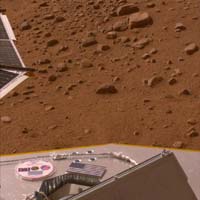Mars Lander's robotic arm activated as radio glitch is repaired
29 May 2008
Mission controllers at NASA's Jet Propulsion Laboratory, Pasadena, successfully sent commands to the Phoenix Mars Lander to start flexing its robotic digging arm Wednesday, a day after a snag in the radio transmission system delayed its deployment. The command was sent through another NASA spacecraft, the Mars Odyssey, which is in orbit around the red planet.
 |
| This image provided by NASA/JPL-Caltech/University of Arizona. The mini-DVD from the Planetary Society contains a message to future Martian explorers, science fiction stories and art inspired by the Red Planet, and the names of more than a quarter million earthlings. |
With MRO's Electra radio system down, controllers could not send the command to deploy the arm to Phoenix. "We are using Odyssey as our primary link until we have a better understanding of what happened with Electra," said Barry Goldstein, JPL's Phoenix project manager.
The robot arm's complex unstowing process involves ''a series of seven moves, beginning with rotating the wrist to release the forearm from its launch restraint," according to Bob Bonitz, the craft's robotic arm manager at JPL. "Another series of moves releases the elbow from its launch restraints and moves the elbow from underneath the bio-barrier."
However, it will still be sometime before the $420 million Phoenix commences its primary mission - digging into the Martian polar soil and sampling water ice. Before it commences its main mission, the robotic arm will initially be positioned beneath the lander to take pictures of the craft's legs and ensure it can provide a stable platform for the mission, mission officials said.
Once stability is ascertained, the craft will spend the next three months digging into the Martian soil to retrieve some of the ice trapped beneath. The Phoenix's sophisticated instrument suite will then be brought into play to analyze the ice and soil to determine whether the ice had melted into liquid water in sufficient quantities to support life sometime in the planet's past.
The Phoenix can only detect conditions favorable to life, and is not capable of discerning the presence of micro-organisms or other organic material. This sophisticated capability will be part of future missions to the planet.
The Lander has sent back some more images of the rust-colored Martian surroundings. These photos show the Lander surrounded by polygonal-shaped patterns on the ground, which scientists believe is indicative of the existence of ice expanding and contracting just beneath the surface.
"We appear to have landed where we have access to digging down a polygon trough the long way, digging across the trough, and digging into the center of a polygon," said Mark Lemmon, a co-investigator on the Phoenix project.
Meanwhile the first weather readings have also come back from the Lander, which show temperatures on the Martian polar surface ranging from a low of minus 112-degrees Fahrenheit to a high of about minus 22-degrees Fahrenheit in the afternoon.




















